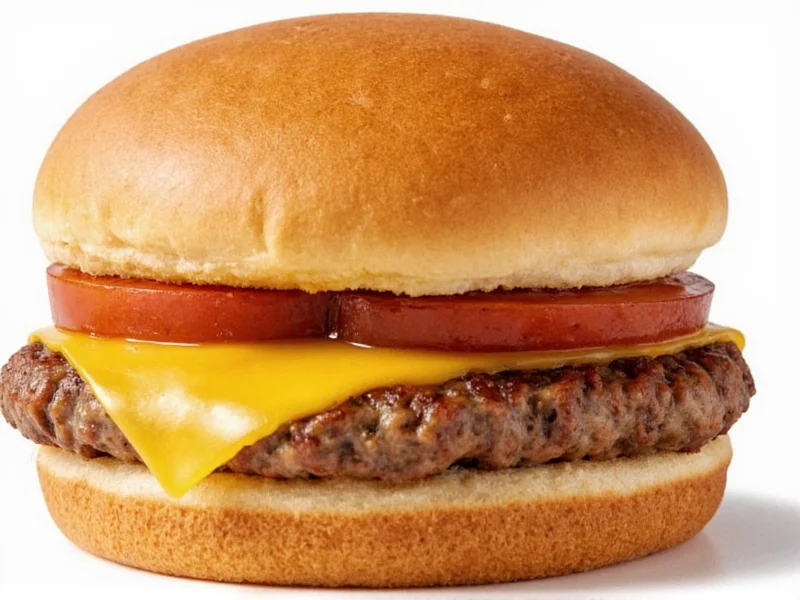When evaluating the sausage mcmuffin nutritional value, it's essential to understand how this fast food breakfast option fits into your daily dietary requirements. McDonald's provides official nutrition information for all menu items, allowing consumers to make informed choices about their meals. The Sausage McMuffin remains one of the chain's most popular breakfast sandwiches since its introduction in 1976.
Nutritional Breakdown of the Sausage McMuffin
Understanding the complete mcdonald's sausage mcmuffin nutritional information requires examining each component. The sandwich's nutritional profile is dominated by its three main ingredients: the pork sausage patty, American cheese, and English muffin. Each element contributes differently to the overall macronutrient and micronutrient composition.
| Nutrient | Amount | % Daily Value* |
|---|---|---|
| Calories | 400 | 20% |
| Total Fat | 24g | 31% |
| Saturated Fat | 9g | 45% |
| Trans Fat | 0.5g | - |
| Cholesterol | 65mg | 22% |
| Sodium | 880mg | 38% |
| Total Carbohydrates | 27g | 10% |
| Dietary Fiber | 1g | 4% |
| Sugars | 2g | - |
| Protein | 16g | 32% |
*Percent Daily Values are based on a 2,000 calorie diet. Your daily values may be higher or lower depending on your calorie needs.
Ingredient Analysis and Nutritional Impact
The sausage mcmuffin calories and nutrition profile reveals important insights about its composition. The pork sausage patty contributes significantly to the fat and protein content, while the English muffin provides most of the carbohydrates. The American cheese adds additional fat and sodium.
When examining whether is sausage mcmuffin healthy, consider that a single sandwich provides nearly half your recommended daily intake of saturated fat. The American Heart Association recommends limiting saturated fat to no more than 5-6% of total daily calories, which for a 2,000 calorie diet equals about 13g. The Sausage McMuffin contains 9g of saturated fat, representing approximately 69% of this recommended limit.
Dietary Context and Health Considerations
For those monitoring their sodium intake, the 880mg in a Sausage McMuffin represents 38% of the American Heart Association's recommended maximum daily sodium intake of 2,300mg (with an ideal limit of 1,500mg for most adults). This makes the sandwich potentially problematic for individuals with hypertension or cardiovascular concerns.
The 16g of protein provides a substantial portion of the recommended daily protein intake, making this sandwich somewhat satisfying despite its nutritional drawbacks. However, the low fiber content (only 1g) means it lacks the sustained energy release that higher-fiber breakfast options would provide.
Comparison with Similar Breakfast Options
When comparing the sausage mcmuffin nutrition facts detailed against other McDonald's breakfast items:
- Egg McMuffin: 300 calories, 12g fat, 5g saturated fat, 790mg sodium, 28g carbohydrates, 17g protein
- Sausage Biscuit: 460 calories, 30g fat, 12g saturated fat, 1,110mg sodium
- Hotcakes with Butter and Syrup: 540 calories, 16g fat, 6g saturated fat, 1,140mg sodium
The Sausage McMuffin sits in the middle range for calories among McDonald's breakfast sandwiches but is notably high in sodium compared to many competitors' breakfast offerings. When evaluating the nutritional value of mcdonald's breakfast items, the Sausage McMuffin provides moderate protein but comes with significant saturated fat and sodium.
Customization Options for Better Nutrition
For those concerned about the sausage mcmuffin macros breakdown, McDonald's offers several customization options that can improve the nutritional profile:
- Order without cheese: Reduces calories by approximately 50 and saturated fat by 3g
- Request egg whites instead of sausage: Creates a significantly lower-fat option
- Ask for no butter on the English muffin: Saves about 45 calories and 5g of fat
- Pair with fruit instead of hash browns for a more balanced meal
These modifications can help create a breakfast that better aligns with various dietary goals while still enjoying the convenience of fast food breakfast options.
Practical Considerations for Different Dietary Goals
For individuals following specific eating patterns, the Sausage McMuffin presents different considerations:
- Weight management: At 400 calories, it can fit within a calorie-controlled breakfast if balanced with lower-calorie options later in the day
- Low-carb diets: With 27g of carbohydrates, it may exceed limits for strict keto diets but could work for more moderate low-carb approaches
- Heart-healthy diets: The high saturated fat and sodium content make this a less ideal choice for cardiovascular health
- High-protein diets: The 16g of protein provides a solid foundation for protein-focused meal planning
Understanding these nuances helps consumers make informed decisions based on their personal health objectives rather than relying on simplistic 'good' or 'bad' food categorizations.











 浙公网安备
33010002000092号
浙公网安备
33010002000092号 浙B2-20120091-4
浙B2-20120091-4